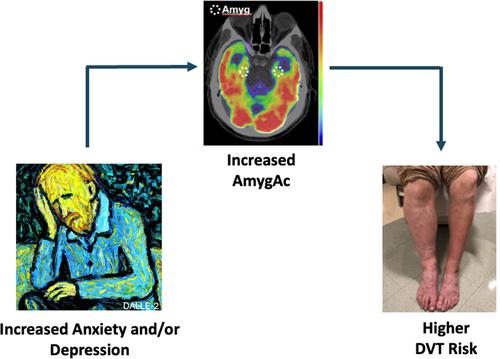当前位置:
X-MOL 学术
›
Am. J. Hematol.
›
论文详情
Our official English website, www.x-mol.net, welcomes your
feedback! (Note: you will need to create a separate account there.)
Anxiety and depression are associated with heightened risk of incident deep vein thrombosis: Mediation through stress-related neural mechanisms
American Journal of Hematology ( IF 10.1 ) Pub Date : 2024-07-04 , DOI: 10.1002/ajh.27427 Rachel P Rosovsky 1 , Kenechukwu Mezue 2, 3 , Charbel Gharios 2 , Giovanni Civieri 2 , Alexander Cardeiro 3 , Hadil Zureigat 3 , Hui Chong Lau 2, 3 , Roger K Pitman 4 , Lisa Shin 4, 5 , Shady Abohashem 3 , Michael T Osborne 2, 3 , Farouc A Jaffer 2 , Ahmed Tawakol 2, 3
American Journal of Hematology ( IF 10.1 ) Pub Date : 2024-07-04 , DOI: 10.1002/ajh.27427 Rachel P Rosovsky 1 , Kenechukwu Mezue 2, 3 , Charbel Gharios 2 , Giovanni Civieri 2 , Alexander Cardeiro 3 , Hadil Zureigat 3 , Hui Chong Lau 2, 3 , Roger K Pitman 4 , Lisa Shin 4, 5 , Shady Abohashem 3 , Michael T Osborne 2, 3 , Farouc A Jaffer 2 , Ahmed Tawakol 2, 3
Affiliation

|
Controversy exists as to whether anxiety and depression increase deep vein thrombosis (DVT) risk, and the mechanisms mediating potential links remain unknown. We aimed to evaluate the association between anxiety and depression and DVT risk and determine whether upregulated stress-related neural activity (SNA), which promotes chronic inflammation, contributes to this link. Our retrospective study included adults (N = 118 871) enrolled in Mass General Brigham Biobank. A subset (N = 1520) underwent clinical 18F-FDG-PET/CT imaging. SNA was measured as the ratio of amygdalar to cortical activity (AmygAC). High-sensitivity C-reactive protein (hs-CRP) and heart rate variability (HRV) were also obtained. Median age was 58 [interquartile range (IQR) 42–70] years with 57% female participants. DVT occurred in 1781 participants (1.5%) over median follow-up of 3.6 years [IQR 2.1–5.2]. Both anxiety and depression independently predicted incident DVT risk after robust adjustment (HR [95% CI]: 1.53 [1.38–1.71], p < .001; and 1.48 [1.33–1.65], p < .001, respectively). Additionally, both anxiety and depression associated with increased AmygAC (standardized beta [95% CI]: 0.16 [0.04–0.27], p = .007, and 0.17 [0.05–0.29], p = .006, respectively). Furthermore, AmygAC associated with incident DVT (HR [95% CI]: 1.30 [1.07–1.59], p = .009). Mediation analysis demonstrated that the link between anxiety/depression and DVT was mediated by: (1) higher AmygAC, (2) higher hs-CRP, and (3) lower HRV ( < .05 for each). Anxiety and depression confer an attributable risk of DVT similar to other traditional DVT risk factors. Mechanisms appear to involve increased SNA, autonomic system activity, and inflammation. Future studies are needed to determine whether treatment of anxiety and depression can reduce DVT risk.
中文翻译:

焦虑和抑郁与深静脉血栓形成的风险增加有关:通过压力相关神经机制进行调节
关于焦虑和抑郁是否会增加深静脉血栓(DVT)风险存在争议,并且介导潜在联系的机制仍不清楚。我们的目的是评估焦虑和抑郁与 DVT 风险之间的关联,并确定上调的压力相关神经活动 (SNA)(促进慢性炎症)是否有助于这种联系。我们的回顾性研究包括在麻省总医院布里格姆生物库登记的成年人 ( N = 118 871)。一个子集 ( N = 1520) 接受了临床18 F-FDG-PET/CT 成像。 SNA 测量为杏仁核与皮质活动的比率 (AmygA C )。还获得了高敏 C 反应蛋白 (hs-CRP) 和心率变异性 (HRV)。中位年龄为 58 [四分位距 (IQR) 42-70] 岁,其中 57% 为女性参与者。中位随访时间为 3.6 年,1781 名参与者 (1.5%) 发生 DVT [IQR 2.1–5.2]。经过稳健调整后,焦虑和抑郁均可独立预测发生 DVT 的风险(HR [95% CI]:分别为 1.53 [1.38–1.71], p < .001;和 1.48 [1.33–1.65], p < .001)。此外,焦虑和抑郁都与AmygAC增加相关(标准化 beta [95% CI]:分别为 0.16 [0.04–0.27], p = 0.007 和 0.17 [0.05–0.29], p = 0.006)。此外,AmygA C与 DVT 事件相关(HR [95% CI]:1.30 [1.07–1.59], p = .009)。中介分析表明,焦虑/抑郁与 DVT 之间的联系是通过以下因素介导的:(1) 较高的AmygAC 、(2) 较高的 hs-CRP 和 (3) 较低的 HRV(各为 < .05)。与其他传统 DVT 危险因素类似,焦虑和抑郁也会带来 DVT 的可归因风险。 机制似乎涉及 SNA 增加、自主系统活动和炎症。未来的研究需要确定治疗焦虑和抑郁是否可以降低 DVT 风险。
更新日期:2024-07-04
中文翻译:

焦虑和抑郁与深静脉血栓形成的风险增加有关:通过压力相关神经机制进行调节
关于焦虑和抑郁是否会增加深静脉血栓(DVT)风险存在争议,并且介导潜在联系的机制仍不清楚。我们的目的是评估焦虑和抑郁与 DVT 风险之间的关联,并确定上调的压力相关神经活动 (SNA)(促进慢性炎症)是否有助于这种联系。我们的回顾性研究包括在麻省总医院布里格姆生物库登记的成年人 ( N = 118 871)。一个子集 ( N = 1520) 接受了临床18 F-FDG-PET/CT 成像。 SNA 测量为杏仁核与皮质活动的比率 (AmygA C )。还获得了高敏 C 反应蛋白 (hs-CRP) 和心率变异性 (HRV)。中位年龄为 58 [四分位距 (IQR) 42-70] 岁,其中 57% 为女性参与者。中位随访时间为 3.6 年,1781 名参与者 (1.5%) 发生 DVT [IQR 2.1–5.2]。经过稳健调整后,焦虑和抑郁均可独立预测发生 DVT 的风险(HR [95% CI]:分别为 1.53 [1.38–1.71], p < .001;和 1.48 [1.33–1.65], p < .001)。此外,焦虑和抑郁都与AmygAC增加相关(标准化 beta [95% CI]:分别为 0.16 [0.04–0.27], p = 0.007 和 0.17 [0.05–0.29], p = 0.006)。此外,AmygA C与 DVT 事件相关(HR [95% CI]:1.30 [1.07–1.59], p = .009)。中介分析表明,焦虑/抑郁与 DVT 之间的联系是通过以下因素介导的:(1) 较高的AmygAC 、(2) 较高的 hs-CRP 和 (3) 较低的 HRV(各为 < .05)。与其他传统 DVT 危险因素类似,焦虑和抑郁也会带来 DVT 的可归因风险。 机制似乎涉及 SNA 增加、自主系统活动和炎症。未来的研究需要确定治疗焦虑和抑郁是否可以降低 DVT 风险。











































 京公网安备 11010802027423号
京公网安备 11010802027423号